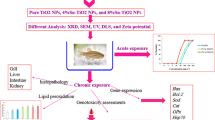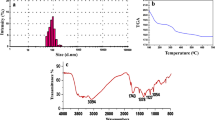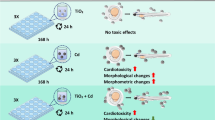Abstract
Increasing use of nanomaterials is resulting in their release into the environment, making necessary to determine the toxicity of these materials. With this aim, the effects of CuO, ZnO and TiO2 nanoparticles (NPs) on zebrafish development were assessed in comparison with the effects caused by the ionic forms (for copper and zinc), bulk counterparts and the stabilizer used for rutile TiO2 NPs. None of the NPs caused significant embryo mortality. CuO NPs were the most toxic affecting hatching and increasing malformation prevalence (≥1 mg Cu/L), followed by ZnO NPs that affected hatching at ≥5 mg Zn/L and stabilized TiO2 NPs that caused mortality and decreased hatching at 100 mg Ti/L. Exposure to the stabilizer alone provoked the same effect. Thus, toxicity of the TiO2 NP suspension can be linked to the surfactant. For all the endpoints, the greatest effects were exerted by the ionic forms, followed by the NPs and finally by the bulk compounds. By autometallography, metal-bearing deposits were observed in embryos exposed to CuO and ZnO NPs, being more abundant in the case of embryos exposed to CuO NPs. The largest and most abundant metal-bearing deposits were detected in embryos exposed to ionic copper. In conclusion, metal oxide NPs affected zebrafish development altering hatching and increasing the prevalence of malformations. Thus, the use and release of metal oxide NPs to the environment may pose a risk to aquatic organisms as a result of the toxicity caused by NPs themselves or by the additives used in their production.






Similar content being viewed by others
References
Alvarado NE, Quesada I, Hylland K, Marigómez I, Soto M (2006) Quantitative changes in metallothionein expression in target cell-types in the gills of turbot (Scophthalmus maximus) exposed to Cd, Cu, Zn and after a depuration treatment. Aquat Toxicol 77:64–77. doi:10.1016/j.aquatox.2005.10.017
Asharani PV, Lian YW, Gong Z, Valiyaveettil S (2008) Toxicity of silver nanoparticles in zebrafish models. Nanotechnology 19:255102. doi:10.1088/0957-4484/19/25/255102
Auffan M, Rose J, Wiesner MR, Bottero J (2009) Chemical stability of metallic nanoparticles: a parameter controlling their potential cellular toxicity in vitro. Environ Pollut 157:1127–1133. doi:10.1016/j.envpol.2008.10.002
Augustine-Rauch K, Zhang CX, Panzica-Kelly JM (2010) In vitro developmental toxicology assays: a review of the state of the science of rodent and zebrafish whole embryo culture and embryonic stem cell assays. Birth Defects Res (Part C) 90:87–98. doi:10.1002/bdrc.20175
Bai W, Zhang Z, Tian W, He X, Ma Y, Zhao Y, Chai Z (2010) Toxicity of zinc oxide nanoparticles to zebrafish embryo: a physicochemical study of toxicity mechanism. J Nanopart Res 12:1645–1654. doi:10.1007/s11051-009-9740-9
Bernardeschi M, Guidi P, Scarcelli V, Frenzilli G, Nigro M (2010) Genotoxic potential of TiO2 on bottlenose dolphin leukocytes. Anal Bioanal Chem 396:619–623. doi:10.1007/s00216-009-3261-3
Buffet P, Tankoua OF, Pan J et al (2011) Behavioral and biochemical responses of two marine invertebrates Scrobicularia plana and Hediste diversicolor to copper oxide nanoparticles. Chemosphere 84:166–174. doi:10.1016/j.chemosphere
Buffet P, Richard M, Caupos F et al (2013) A mesocosm study of fate and effects of CuO nanoparticles on endobenthic species (Scrobicularia plana, Hediste diversicolor). Environ Sci Technol 47:1620–1628. doi:10.1021/es303513r
Busch W, Duis K, Fenske M et al (2011) The zebrafish embryo model in toxicology and teratology. Reprod Toxicol 31:585–588. doi:10.1016/j.reprotox.2011.02.010
Chen J, Dong X, Xin Y, Zhao M (2011a) Effects of titanium dioxide nano-particles on growth and some histological parameters of zebrafish (Danio rerio) after a long-term exposure. Aquat Toxicol 1001:493–499. doi:10.1016/j.aquatox.2010.12.004
Chen D, Zhang D, Yu JC, Chan KM (2011b) Effects of Cu2O nanoparticles and CuCl2 on zebrafish larvae and a liver cell-line. Aquat Toxicol 105:344–354. doi:10.1016/j.aquatox.2011.07.005
Chio C, Chen W, Chou W, Hsieh N, Ling M, Liao C (2012) Assessing the potential risks to zebrafish posed by environmentally relevant copper and silver nanoparticles. Sci Total Environ 420:111–118. doi:10.1016/j.scitotenv.2012.01.023
Clearwater SJ, Farag AM, Meyer JS (2002) Bioavailability and toxicity of dietborne copper and zinc to fish. Comp Biochem Physiol 132C:269–313. doi:10.1016/S1532-0456(02)00078-9
Clemente Z, Castro VL, Feitosa LO, Lima R, Jonsson CM, Maia AHN, Fraceto LF (2013) Fish exposure to nano-TiO2 under different experimental conditions: methodological aspects for nanoecotoxicology investigations. Sci Total Environ 463–464:566–647. doi:10.1016/j.scitotenv.2013.06.022
Donaldson K, Stone V, Tran CL, Kreyling W, Born P (2004) Nanotoxicology. Occup Environ Med 61:727–728. doi:10.1136/oem.2004.013243
Fako V, Furgeson D (2009) Zebrafish as a correlative and predictive model for assessing biomaterial nanotoxicity. Adv Drug Deliv Rev 61:478–486. doi:10.1016/j.addr.2009.03.008
Fries R, Simko M (2012) Nano-titanium dioxide (Part I): basics, production, applications. NanoTrust-Dossier No. 033en. epub.oeaw.ac.at/ita/nanotrust-dossiers/dossier033en.pdf. ISSN:1998–7293. Accessed 5 June 2013
Gottschalk F, Sonderer T, Schloz RW, Nowack B (2009) Modeled environmental concentrations of engineered nanomaterials (TiO2, ZnO, Ag, CNT, Fullerenes) for different regions. Environ Sci Technol 43:9216–9222. doi:10.1021/es9015553
Griffitt RJ, Weil R, Hyndman KA, Denslow ND, Powers K, Taylor D, Barber DS (2007) Exposure to copper nanoparticles causes gill injury and acute lethality in zebrafish (Danio rerio). Environ Sci Technol 41:8178–8186. doi:10.1021/es071235e
Griffitt RJ, Lou J, Gao J, Bonzongo J, Barber DS (2008) Effects of particle composition and species on toxicity of metallic nanomaterials in aquatic organisms. Environ Toxicol Chem 27:1972–1978. doi:10.1897/08-002.1
Grosell M, Blanchard J, Brix KV, Gerdes R (2007) Physiology is pivotal for interactions between salinity and acute copper toxicity to fish and invertebrates. Aquat Toxicol 84:162–172. doi:10.1016/j.aquatox.2007.03.026
Hallare A, Nagel K, Köhler HR, Triebskorn R (2006) Comparative embryo toxicity and proteotoxicity of three carrier solvents to zebrafish (Danio rerio) embryos. Ecotox Environ Safe 63:378–388. doi:10.1016/j.ecoenv.2005.07.006
Handy RD, Henry TB, Scown TM, Johnston BD, Tyler CR (2008) Manufactured nanoparticles: their uptake and effects on fish-a mechanistic analysis. Ecotoxicology 17:396–409. doi:10.1007/s10646-008-0205-1
Heinlaan M, Ivask A, Blinova I, Dubourguier H, Kahru A (2008) Toxicity of nanosized and bulk ZnO, CuO and TiO2 to bacteria Vibrio fischeri and crustaceans Daphnia magna and Thamnocephalus platyurus. Chemosphere 71:1308–1316. doi:10.1016/j.chemosphere.2007.11.047
Hill A, Teraoka H, Heideman W, Peterson R (2005) Zebrafish as a model vertebrate for investigating chemical toxicity. Toxicol Sci 86:6–19. doi:10.1093/toxsci/kfi110
Hund-Rinke K, Simon M (2006) Ecotoxic effect of photocatalytic active nanoparticles (TiO2) on algae and daphnids. Environ Sci Pollut Res 13:1–18. doi:10.1065/espr2006.06.311
Johnston BD, Scown TM, Moger J et al (2010) Bioavailability of nanoscale metal oxides TiO2, CeO2, and ZnO to fish. Environ Sci Technol 44:1144–1151. doi:10.1021/es901971a
Ju-Nam Y, Lead JR (2008) Manufactured nanoparticles: an overview of their chemistry, interactions and potential environmental implications. Sci Total Environ 400:396–414. doi:10.1016/j.scitotenv.2008.06.042
Kasemets K, Ivask A, Dubourguier H, Kahru A (2009) Toxicity of nanoparticles of ZnO, CuO and TiO2 to yeast Saccharomyces cerevisiae. Toxicol In Vitro 23:1116–1122. doi:10.1016/j.tiv.2009.05.015
Katsumiti A, Berhanu D, Howard KT, Valsami-Jones E, Oron M, Reip P, Cajaraville MP (2014) Cytotoxicity of TiO2 nanoparticles to mussel hemocytes and gill cells in vitro. Nanotoxicology (in press)
Kimmel C, Ballard W, Kimmel S, Ullmann B, Schilling T (1995) Stages of embryonic development of the zebrafish. Dev Dyn 203:253–310. doi:10.1002/aja.1002030302
King-Heiden TC, Wiecinski PN, Mangham AN et al (2009) Quantum dot nanotoxicity assessment using the zebrafish embryo. Environ Sci Technol 43:1605–1611. doi:10.1021/es801925c
Lammer E, Carr GJ, Wendler K, Rawling JM, Belanger SE, Braunbeck T (2009) Is the fish embryo test (FET) with the zebrafish (Danio rerio) a potential alternative for the fish acute toxicity test? Comp Biochem Physiol 149C:196–209. doi:10.1016/j.cbpc.2008.11.006
Larsson A, Lehtinen K, Haux C (1980) Biochemical and hematological effects of a titanium dioxide industrial effluent on fish bull. Environ Contam Toxicol 25:427–435. doi:10.1007/BF01985550
Lee KJ, Nallathamby PD, Browning LM, Osgood CJ, Xu XN (2007) In vivo imaging of transport and biocompatibility of single silver nanoparticles in early development of zebrafish embryos. ACS Nano 1:133–143. doi:10.1021/nn700048y
Lee J, Mahendra S, Alvarez PJJ (2010) Nanomaterials in the construction industry: a review of their applications and environmental health and safety considerations. ACS Nano 4:3580–3590. doi:10.1021/nn100866w
Lin S, Zhao Y, Xia T et al (2011) High content screening in zebrafish speeds up hazard ranking of transition metals oxide nanoparticles. ACS Nano 5:7284–7295. doi:10.1021/nn202116p
Lin S, Zhao Y, Ji Z et al (2012) Zebrafish high-throughput screening to study the impact of dissolvable metal oxide nanoparticles on the hatching enzyme, ZHE1. Small 9:1776–1785. doi:10.1002/smll.201202128
Macwan DP, Dave PN, Chaturvedi S (2011) A review on nano-TiO2 sol–gel type syntheses and its applications. J Mater Sci 46:3669–3686. doi:10.1007/s10853-011-5378-y
Marigómez I, Soto M, Cajaraville MP, Angulo E, Giamberini L (2002) Cellular and subcellular distribution of metals in molluscs. Microsc Res Tech 56:358–392. doi:10.1002/jemt.10040
Maynard AD, Butz T, Aitken R et al (2006) Safe handling of nanotechnology. Nature 444:267–269. doi:10.1038/444267a
Mela M, Cambier S, Mesmer-Dudons N et al (2010) Methylmercury localization in Danio rerio retina after trophic and subchronic exposure: a basis for neurotoxicology. Neurotoxicology 31:448–453. doi:10.1016/j.neuro.2010.04.009
Misra SK, Dybowska A, Berhanu D, Luoma SN, Valsami-Jones E (2012) The complexity of nanoparticles disolution and its importance in nanotoxicological studies. Sci Tot Environ 238:225–232. doi:10.1016/j.scitotenv.2012.08.066
Nagel R (2002) DarT: the embryo test with the zebrafish Danio rerio—a general model in ecotoxicology and toxicology. ALTEX 19:38–48
Niemeyer CM (2001) Nanoparticles, proteins, and nucleic acids: biotechnology meets materials science. Angew Chem Int Ed 40:4128–4158. doi:10.1002/1521-3773(20011119)40:22<4128:AID-ANIE4128>3.0.CO;2-S
Nowack B, Bucheli TD (2007) Occurrence, behavior and effects of nanoparticles in the environment. Environ Pollut 150:5–22. doi:10.1016/j.envpol.2007.06.006
Oberdörster G, Oberdörster E, Oberdörster J (2005) Nanotoxicology: an emerging discipline evolving from studies of ultrafine particles. Environ Health Perspect 113:823–839. doi:10.1289/ehp.7339
Ren G, Hu D, Cheng EWC, Vargas-Reus MA, Reip P, Allaker RP (2009) Characterization of copper oxide nanoparticles for antimicrobial applications. Int J Antimicrob Ag 33:587–590. doi:10.1016/j.ijantimicag.2008.12.004
Shaw BJ, Handy RD (2011) Physiological effects of nanoparticles on fish: a comparison of nanometals versus metal ions. Environ Int 31:1083–1097. doi:10.1016/j.envint.2011.03.009
Soto M, Cajaraville MP, Marigómez I (1996) Tissue and cell distribution of copper, zinc and cadmium in the mussel, Mytilus galloprovincialis, determined by autometallography. Tissue Cell 28:557–568. doi:10.1016/S0040-8166(96)80058-9
Spitsbergen JM, Kent ML (2003) The state of the art of the zebrafish model for toxicology and toxicologic pathology research-advantages and current limitations. Toxicol Pathol 31:62–87. doi:10.1080/01926230390174959
Stohs SJ, Bagchi D (1995) Oxidative mechanisms in the toxicity of metal ions. Free Rad Biol Med 18:321–336. doi:10.1016/0891-5849(94)00159-H
Teraoka H, Dong W, Hiraga T (2003) Zebrafish as a novel experimental model for developmental toxicology. Congenit Anom 43:123–132. doi:10.1111/j.1741-4520.2003.tb01036.x
Thomas RC, George S, Horst M et al (2011) Nanomaterials in the environment: from materials to high-throughput screening to organisms. ACS Nano 5:13–20. doi:10.1021/nn1034857
Vaseem M, Umar A, Hahn YB (2010) ZnO nanoparticles: growth, properties, and applications. In: Umar A and Hahn YB (eds) Metal oxide nanostructures and their applications. American Scientific Publishers, pp 1–36
Wang J, Zhu Z, Zhang X et al (2011) Disruption of zebrafish (Danio rerio) reproduction upon chronic exposure to TiO2 nanoparticles. Chemosphere 83:461–467. doi:10.1016/j.chemosphere.2010.12.069
Wang Z, Li N, White J, Qu P, Xing B (2012) CuO nanoparticle interaction with human epithelial cells: cellular uptake, location, export, and genotoxicity. Chem Res Toxicol 25:1512–1521. doi:10.1021/tx3002093
Wang J, Gerlach JD, Savage N, Cobb GP (2013) Necessity and approach to integrated nanomaterial legislation and governance. Sci Tot Environ 442:56–62. doi:10.1016/j.scitotenv.2012.09.073
Warheit DB, Sayes CM, Reed KL, Swain KA (2008) Health effects related to nanoparticle exposures: environmental, health and safety considerations for assessing hazards and risks. Pharmacol Ther 120:35–42. doi:10.1016/j.pharmthera.2008.07.001
Xiong D, Fang T, Yu L, Sima X, Zhu W (2011) Effects of nano-scale TiO2, ZnO and their bulk counterparts on zebrafish: acute toxicity, oxidative stress and oxidative damage. Sci Tot Environ 409:1444–1452. doi:10.1016/j.scitotenv.2011.01.015
Yang L, Ho NY, Alshut R et al (2009) Zebrafish embryos as models for embryotoxic and teratogenical effects of chemicals. Reprod Toxicol 28:245–253. doi:10.1016/j.reprotox.2009.04.013
Yu L, Fang T, Xiong D, Zhu W, Sima X (2011) Comparative toxicity of nano-ZnO and bulk ZnO suspensions to zebrafish and the effects of sedimentation, OH production and particle dissolution in distilled water. J Environ Monit 13:1975–1982. doi:10.1039/c1em10197h
Zhao X, Wang S, Wu Y, You H, Lv L (2013) Acute ZnO nanoparticles exposure induces developmental toxicity, oxidative stress and DNA damage in embryo-larval zebrafish. Aquat Toxicol 136–137:49–59. doi:10.1016/j.aquatox.2013.03.019
Zhu X, Zhu L, Li Y, Duan Z, Chen W, Alvarez PJ (2007) Developmental toxicity in zebrafish (Danio rerio) embryos after exposure to manufactured nanomaterials: buckminsterfullerene aggregates (nC60) and fullerol. Environ Toxicol Chem 26:976–979. doi:10.1897/06-583.1
Zhu X, Zhu L, Duan Z, Qi R, Li Y, Lang Y (2008) Comparative toxicity of several metal oxide nanoparticle aqueous suspensions to zebrafish (Danio rerio) early developmental stage. J Environ Sci Health A 43:278–284. doi:10.1080/10934520701792779
Zhu X, Wang J, Zhang X, Chang Y, Chen Y (2009) The impact of ZnO nanoparticle aggregates on the embryonic development of zebrafish (Danio rerio). Nanotechnology 20:195103. doi:10.1088/0957-4484/20/19/195103
Acknowledgments
This work has been funded by the European Commission’s Seventh Framework Programme (Grant agreement no° 214478, project NanoReTox), the Spanish Ministry of Science and Innovation (MICINN) (Nanocancer project CTM2009-13477), the University of the Basque Country (UPV/EHU) through a PhD fellowship to UVP and UFI 11/37 and Basque Government through a grant to consolidated research groups (GIC07/26-IT-393-07 and IT810-13). Laura-Jayne Ellis at the University of Birmingham is thanked for supplying the TEM image of ZnO nanoparticles.
Author information
Authors and Affiliations
Corresponding author
Rights and permissions
About this article
Cite this article
Vicario-Parés, U., Castañaga, L., Lacave, J.M. et al. Comparative toxicity of metal oxide nanoparticles (CuO, ZnO and TiO2) to developing zebrafish embryos. J Nanopart Res 16, 2550 (2014). https://doi.org/10.1007/s11051-014-2550-8
Received:
Accepted:
Published:
DOI: https://doi.org/10.1007/s11051-014-2550-8




